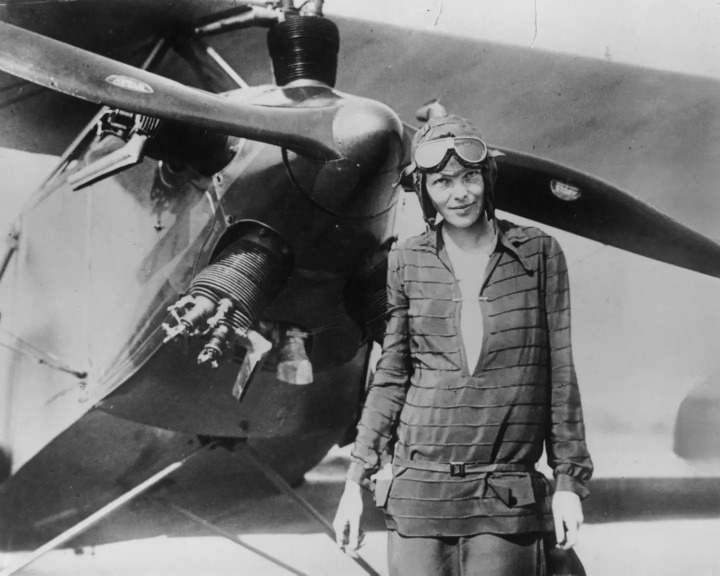For almost nine decades, one name has continued to echo through the skies of history — Amelia Earhart. Her story is not merely a tale of aviation; it’s a chronicle of human courage, limitless curiosity, and the eternal desire to chase horizons that lie just beyond sight.
On the morning of July 2, 1937, Earhart took off on what was meant to be the most ambitious flight ever attempted by a woman — a daring mission to circle the globe in her twin-engine Lockheed Electra. She and her navigator, Fred Noonan, soared into the Pacific skies, filled with hope and determination. But somewhere between Lae, New Guinea, and Howland Island, their voices faded into silence.
No distress signal. No wreckage. No goodbye.
In the years that followed, that silence became one of the greatest enigmas in modern history — a puzzle that has endured through generations of searchers, storytellers, and dreamers determined to uncover what really happened to the woman who refused to be grounded by limits.
Now, eighty-eight years later, the world may finally be on the brink of an answer. Recent discoveries beneath the waves of the Pacific suggest that Earhart’s plane — long lost and long sought — may have finally been found.
The Woman Who Challenged the Sky
Long before she vanished, Amelia Earhart had already carved her name into the skies. Born in 1897, she grew up with a fierce sense of independence and curiosity. At a time when the world expected women to remain quiet and reserved, Amelia defied convention — she wanted to fly.
When she earned her pilot’s license in 1923, only a handful of women in the world had achieved the same. Aviation was still in its infancy, but Amelia saw it as a way to expand human potential. She often said, “Adventure is worthwhile in itself.”
In 1932, she became the first woman to fly solo across the Atlantic Ocean, an achievement that made her an international sensation. Newspapers called her “Lady Lindy” — comparing her to Charles Lindbergh — but her goal wasn’t fame. Amelia flew to prove that courage had no gender, and that women were capable of anything they set their minds to.
Her daring flights, calm confidence, and pioneering spirit made her a symbol of progress. She inspired not only pilots but also writers, scientists, and students — anyone who dreamed of transcending limits.
The Final Flight
By 1937, Earhart’s ambition had reached its highest altitude yet — she wanted to circumnavigate the globe along the equator, the longest route possible. It was a flight that would stretch the limits of both technology and endurance.
Flying a Lockheed Electra Model 10-E, she set off with navigator Fred Noonan on an eastward journey that would span 29,000 miles.
The first stages went smoothly — across the Americas, Africa, India, and Southeast Asia. But when they left Lae, New Guinea, for Howland Island, something went wrong.
Radio contact grew weak. Static filled the airwaves. Earhart’s final transmission came through with strained clarity:
“We are on the line 157–337… We are running north and south.”
Then — silence.
That silence grew louder with time. Search crews scoured the Pacific, ships and aircraft sweeping thousands of miles of open sea. The United States Navy spent nearly $4 million in one of the largest search operations in history, but no trace was ever found.
Amelia Earhart and Fred Noonan had vanished into legend.
A Century of Searching
The years that followed turned her disappearance into a mystery that captured imaginations around the world. Scientists, explorers, and amateur investigators launched countless expeditions.
Some believed the Electra had crashed into the ocean, its remains swallowed by the deep. Others suspected she may have landed on an uninhabited island, surviving for days or weeks before succumbing to isolation.
More speculative theories claimed capture by foreign forces or secret missions gone awry, but no verifiable evidence ever supported these ideas.
What kept the mystery alive wasn’t conspiracy — it was hope. Hope that someday, the Pacific would reveal its secret. Hope that the woman who inspired millions could finally be found.
Modern Science Meets a Century-Old Mystery
Decades passed, but technology evolved. The tools of exploration became far more advanced than anything Earhart could have imagined in her time.
In early 2025, an international team of marine archaeologists and ocean engineers set out to explore a region of the Pacific known as the Howland Island Corridor — an area long believed to be near her final flight path. Using autonomous underwater vehicles (AUVs) equipped with high-resolution sonar imaging and magnetometric scanning, they began to map the ocean floor at unprecedented depth and detail.
What they found left them speechless.
Hidden more than 16,000 feet beneath the surface, the AUVs detected the faint outline of metallic debris, partially buried in coral and sand. The shape, size, and structure appeared consistent with the Lockheed Electra 10-E — the very aircraft Earhart flew on her final voyage.
When divers later reviewed the visual data, they noticed landing gear, engine mounts, and rivet patterns identical to those of Earhart’s plane. Every clue brought them closer to a truth that had eluded humanity for nearly nine decades.
Dr. Patrick Reynolds, the mission’s lead archaeologist, recalled the moment vividly:
“When we saw the first image, the world seemed to stop. The structure, the curvature — it matched perfectly. It felt like Amelia was finally reaching back to us through time.”
Piecing Together the Evidence
Of course, extraordinary discoveries demand extraordinary verification. Every piece of debris has been carefully catalogued, scanned, and compared against Lockheed factory blueprints from the 1930s.
Experts in metallurgy are analyzing the alloy composition of the recovered fragments, while aviation engineers study rivets and fasteners to ensure they match the manufacturing techniques of the Electra’s era.
The evidence so far aligns remarkably well — but scientific confirmation takes time. Teams from universities and research institutions around the world are collaborating to ensure that every finding is rigorously tested before any official declaration is made.
Meanwhile, the world watches with anticipation. News outlets, documentaries, and aviation enthusiasts follow every update, eager to know whether one of history’s most famous mysteries is finally nearing resolution.
Understanding the Final Moments
Based on the latest data and analysis, researchers now believe Earhart may have attempted an emergency water landing after running low on fuel and losing sight of Howland Island.
The ocean currents and depth patterns in the region match the debris location almost precisely. Sonar imaging suggests the aircraft came down intact before being gradually pulled beneath the waves by shifting sands and coral growth.
It’s a hauntingly poetic image — the Electra resting quietly in the depths of the ocean, undisturbed for nearly a century, waiting for technology and persistence to rediscover it.
More Than Just a Mystery
Yet, to focus solely on the wreckage would be to miss the true essence of Amelia Earhart’s legacy. She wasn’t merely a pilot lost to time — she was a pioneer who changed what the world believed women could do.
Dr. Melissa Grant, a historian specializing in early aviation, explained it best:
“Finding her plane isn’t just about solving a mystery. It’s about honoring a legacy — a life lived without fear, a woman who refused to accept the word ‘impossible.’”
Earhart’s courage paved the way for countless others — women who became astronauts, engineers, and leaders. Every milestone achieved in the skies or beyond owes a small debt to the woman who once said, ‘The most effective way to do it, is to do it.’
A Lesson in Perseverance
The enduring search for Amelia Earhart’s plane has become a reflection of her own values — determination, curiosity, and resilience.
Every expedition that set out to find her, even those that came back empty-handed, carried the same spirit she embodied: never giving up.
The scientists and explorers who devoted years to studying her flight path weren’t just chasing wreckage; they were chasing understanding. They wanted to complete a story that has inspired humanity for nearly a century.
As new technologies reveal what the human eye once could not, her story reminds us that progress is born from persistence — and that no mystery is unsolvable when met with patience and purpose.
Rewriting History
Should this discovery be confirmed, the implications would be profound. It would close one of the most famous chapters in aviation history and give historians a clearer picture of the final moments of a global icon.
But it would also highlight something deeper: the unbroken connection between human ambition and scientific innovation.
From the days of wooden propellers to the era of autonomous underwater drones, the same spirit that drove Earhart into the sky now drives researchers beneath the sea. Both journeys share the same purpose — to uncover, to understand, and to inspire.
The Spirit That Never Vanished
Even if her plane has been found, Amelia Earhart’s story is not over — because her real legacy is not a machine, but a mindset.
She showed the world that dreams are worth the risk, that exploration is not defined by success alone, but by the courage to begin.
Her words, her photographs, and her accomplishments have continued to inspire for generations. Young girls who see her name in textbooks understand that limits are illusions, and that bravery isn’t the absence of fear — it’s the strength to rise above it.
Earhart once said, “Never interrupt someone doing something you said couldn’t be done.”
Nearly 90 years later, her voice still resonates — not from a radio, but from the collective spirit of humanity’s dreamers and explorers.
The Ocean’s Whisper
As scientists continue to analyze the newly discovered wreckage, the Pacific holds its breath. The same ocean that once claimed her may now be ready to tell her story.
The sun sets over calm waves, and somewhere beneath them, perhaps, rests the aircraft that carried one of history’s bravest souls.
For all these decades, she has remained a symbol — not of loss, but of limitless hope.
Her disappearance sparked generations of explorers, her courage ignited movements for equality, and her determination continues to guide adventurers into the unknown.
In the end, Amelia Earhart never truly disappeared. She simply soared beyond the reach of her time — leaving behind a trail of inspiration that still glows across the sky.
A Legacy Beyond the Clouds
The rediscovery of Amelia Earhart’s plane would bring closure to a mystery, but more importantly, it would reaffirm what her life always stood for — boldness, resilience, and discovery.
Every time a pilot takes off into uncertain skies, every time a scientist dives into the unexplored depths of the ocean, or a child dares to dream of doing the impossible — Amelia’s spirit is there.
Her journey reminds us that courage has no boundaries and that exploration, in every form, defines what it means to be human.
Eighty-eight years later, as technology finally catches up with history, the world prepares to welcome back a legend — not from the clouds she once ruled, but from the deep, quiet heart of the ocean that now whispers her name.




